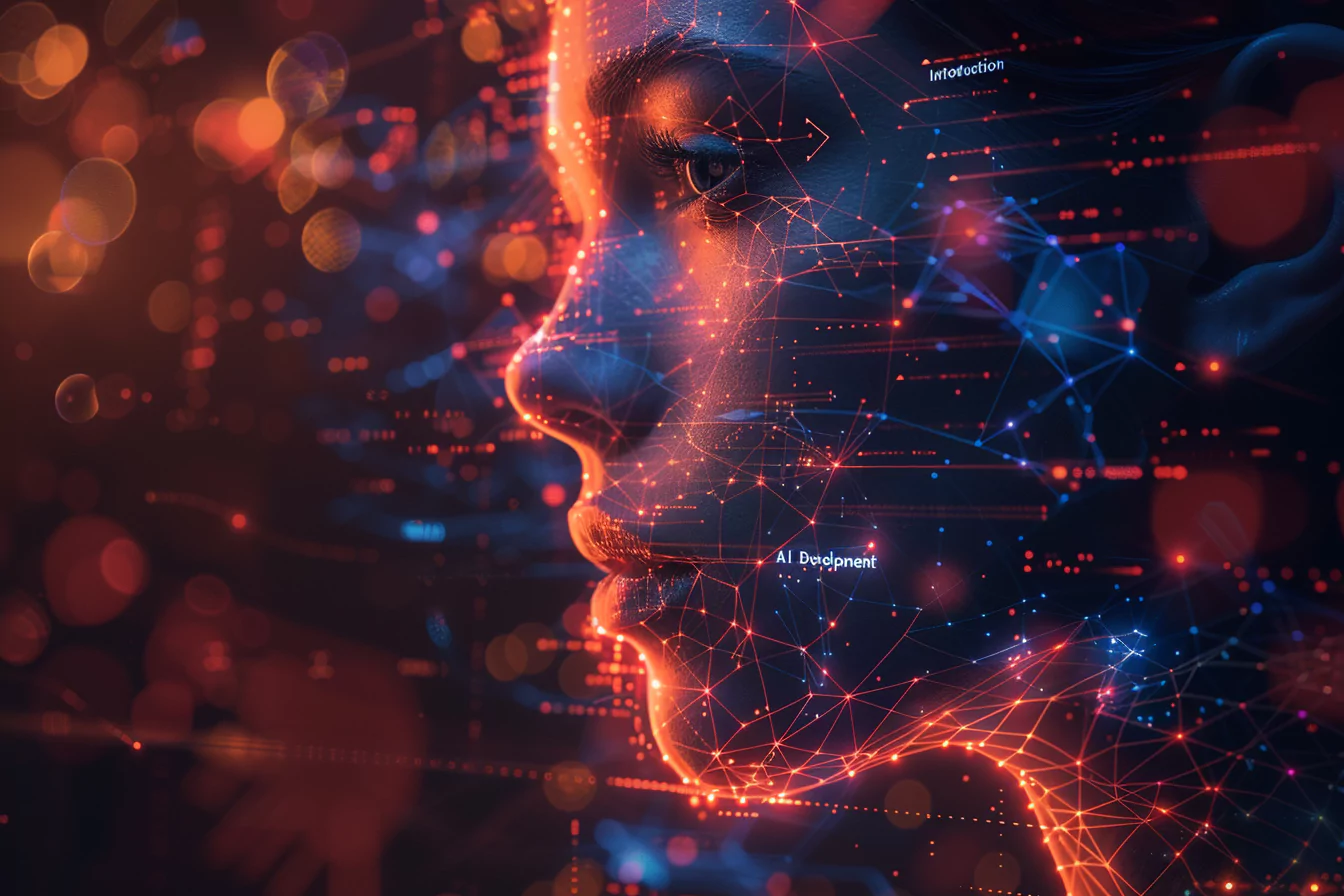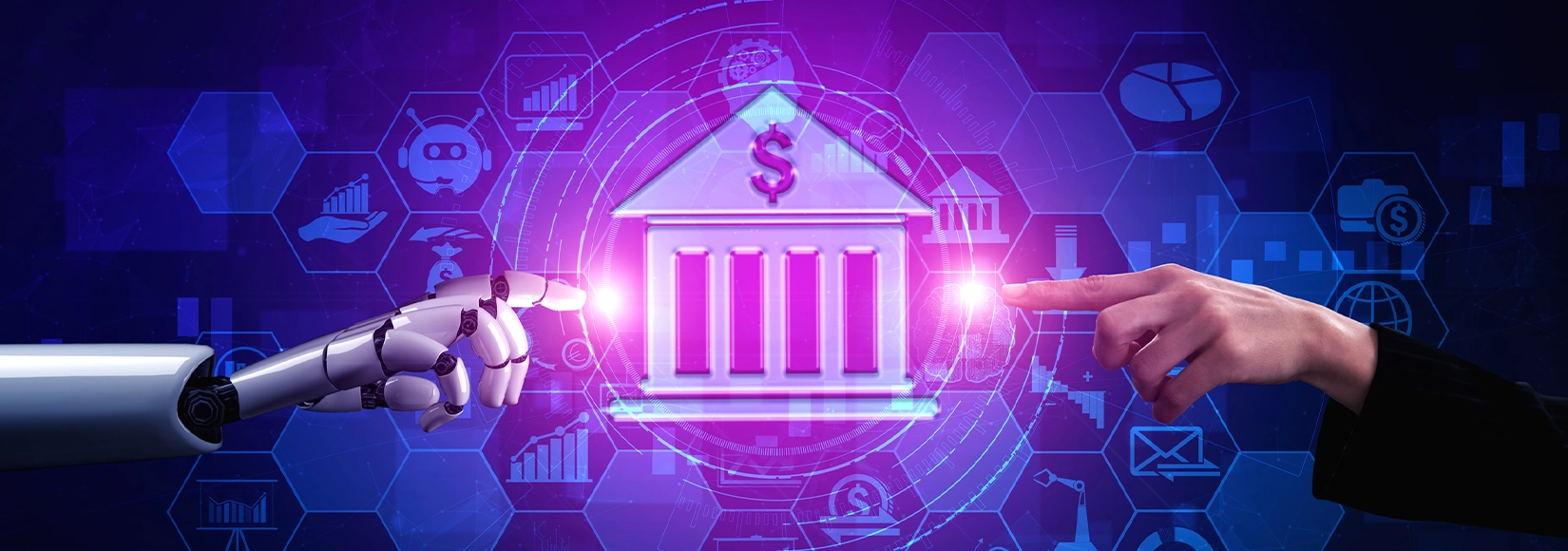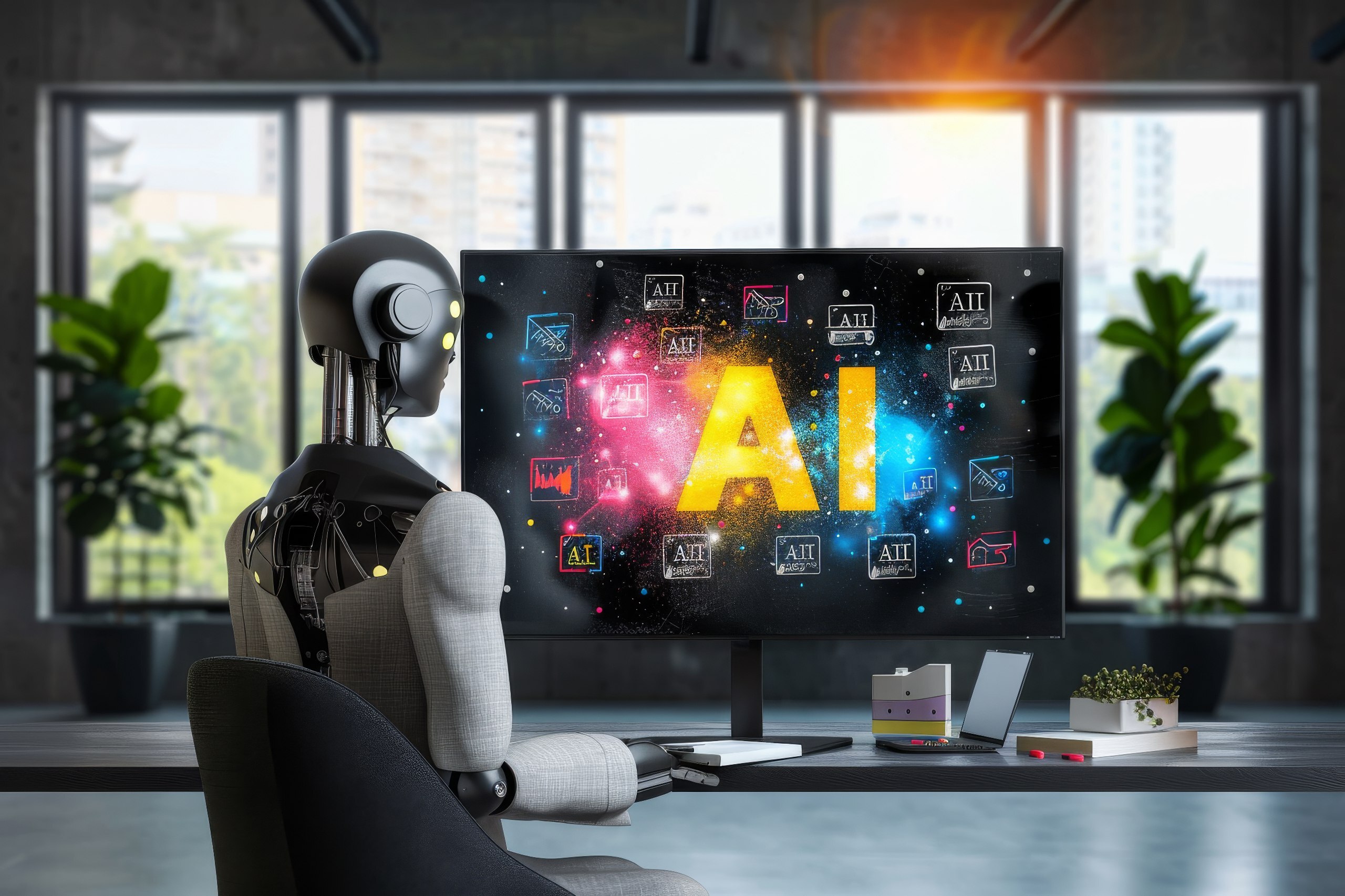ARTIFICIAL INTELLIGENCE- A common and famous technology dominating the world today. As technology continues to grow and transform, it is a word we hear almost everywhere. But What exactly is AI? Why is it becoming so popular daily?
Do you know that even if we are surrounded by AI, in one form or another, many forms and potentials of AI are still yet to be uncovered? What if I tell you that we have currently unfolded only about 10-20% (vaguely saying) of AI’s potential?
Continue reading this blog, and you’ll learn about AI, how it evolved, its forms & branches, impact, challenges, and future. Stay Tuned; there is so much more to come!
What Is Artificial Intelligence And Why Is It Important?
Artificial intelligence refers to putting human-like capabilities like intelligence, cognitive thinking, sensing power, and behavioral aspects into machines and software. Its importance lies in its potential to transform various sectors drastically, enhancing efficiency, accuracy, and innovation, resulting in improved quality of life on Earth.
AI systems can process huge amounts of data, analyze it, recognize the running patterns, and make predictions or decisions based on that analysis. This feature holds immense value across various industries, from healthcare and finance to transportation and entertainment, and has the power to speed up all the processes. Moreover, certain techniques like Natural Language Processing (NLP) and Computer Vision (CV) also allow AI models to understand human languages and recognize visual information. Thus, by automating tasks and inheriting human capabilities and knowledge, AI is bringing new forms of creativity into the world and driving significant advancements to reshape our lifestyles.
Types Of Artificial Intelligence.
Altogether, we have seven kinds of AI, further broadly categorized into two forms based on their capabilities and functionalities.
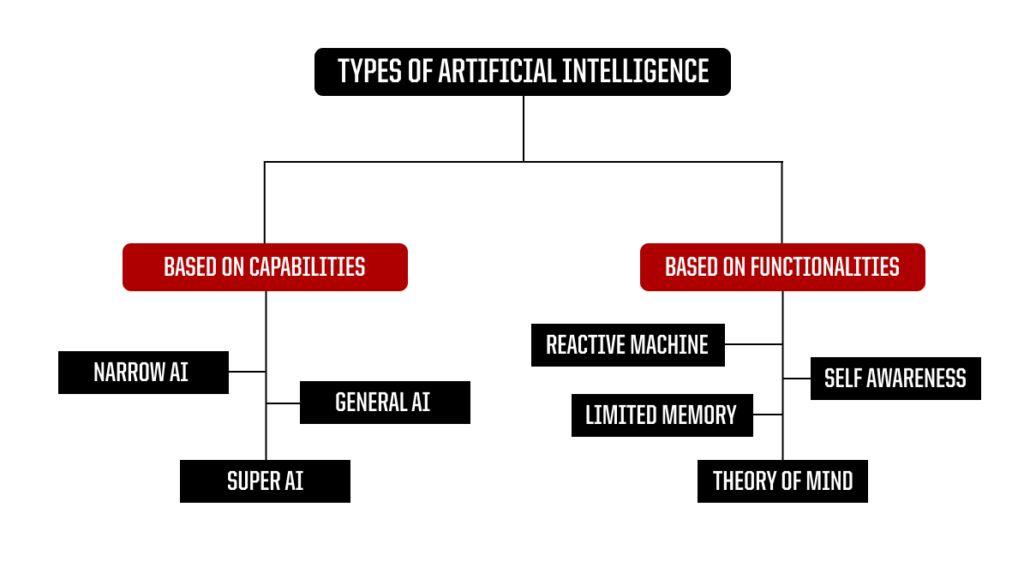
Based on its capabilities, AI is classified into three forms: Narrow AI, General AI, and the most superficial form, Super-Intelligence.
Narrow AI: Sometimes called Weak AI or Specialized AI, it works in a limited context and applies human intelligence to a specific problem or task (like transcribing human speech, driving a car, or website content curation). Narrow AI might lack the broad cognitive abilities of humans, but they perform their respective tasks quite well.
Examples include-
- Siri or Alexa (Virtual assistants)
- Self Driving Cars
- Netflix Recommendation Systems
- Chat GPT or Google Gemini (Conversational Bots).
So, almost all the forms of AI that we are using are Weak AI, Like Imagine…. the more advanced forms have still not been completely discovered. Let’s read about them.
General AI: Also known as Strong AI. In contrast to narrow AI, General AI has a full set of cognitive abilities of a human being. This form of AI can understand, learn, apply what it knows, or even solve the problem it has never been trained on, hence equaling human intelligence.
Developing a General AI can be a holy grail for researchers. However, time has yet to ease the difficulty of achieving such a remarkable deed. In addition, AI has a dark side, and there are some potential risks in developing this powerful AI; let’s see what time brings us in the future.
Super-intelligence (Super AI): It is a hypothetical form of AI considered the most advanced, powerful, and intelligent. Super AI surpasses human intelligence in every aspect, including creativity, problem-solving, and social skills. However, as exciting as imagining such AI is, it raises profound philosophical and existential questions about the nature of consciousness and the future of humanity.
While weak AI persists in today’s world, researchers continue to work on bringing strong AI to the physical world and discovering the implications of Artificial Superintelligence.
Based on its Functionalities, AI is classified into four forms:
- Reactive Machine/ Purely Reactive
- Limited Theory
- Theory of Mind
- Self Awareness
Reactive Machine: A reactive machine is a form of AI that makes decisions based on events around it. It doesn’t record any data to be used in the future for decision-making. They are designed for specific tasks. They understand and react to the world’s present actions only.
IBM Deep Blue, which defeated chess grandmaster Garry Kasparov, is a reactive machine that looks at the chess game pieces, identifies and recognizes how they move, and then reacts to it. It doesn’t play based on past experiences or improve with time. Hence, it only considers the ongoing game and plays according to it.
Limited Theory: Limited theory is also called limited memory. As the name suggests, these AI models only store data for a limited period. They can respond based on the recently collected data for a short time but can’t keep it in the library of experiences for later use.
ChatGPT is an example of a Limited Theory Large Language Model (LLM). A large language model is a machine learning model that can perform various NLP tasks like generating text, etc. ChatGPT responds to the user based on the information and the user’s words.
Theory of Mind: Theory of mind AI is an advanced form of AI mostly found in books or as a concept only. It is a form of AI that can understand, feel, and react to human emotions and behavior. Even though humankind has achieved some part of the theory of mind AI, we have yet to accomplish its entirety.
Real-world examples of theory of mind AI include “Kismet” and “Sophia.” Kismet is a robot head with eyes, eyebrows, eyelids, lips, and jaw. It can mimic human behavior and recognize it. However, it still lacks responsiveness and doesn’t pay attention to human beings. On the other hand, Sophia is a female-like robot with a camera fitted in her eyes. She can see and recognize people and maintain eye contact with them.
Self-Awareness: This is the most advanced AI model to understand and reciprocate human emotions, feelings, needs, and beliefs. As exciting as the idea is, it is still hypothetical and would raise many questions about the potential risks following its discovery.
Gosh! You now know about all the seven forms of AI and can think of how much potential it holds to transform life on Earth.
Question: Have you ever watched Doraemon? Now, what type of AI is it?
Answer: We hope you were right. It’s an idea of a Self-Aware Super Intelligent AI model.
History and Evolution of AI:
Below is the timeline of the rise of Artificial Intelligence, defining how it gained popularity over time.
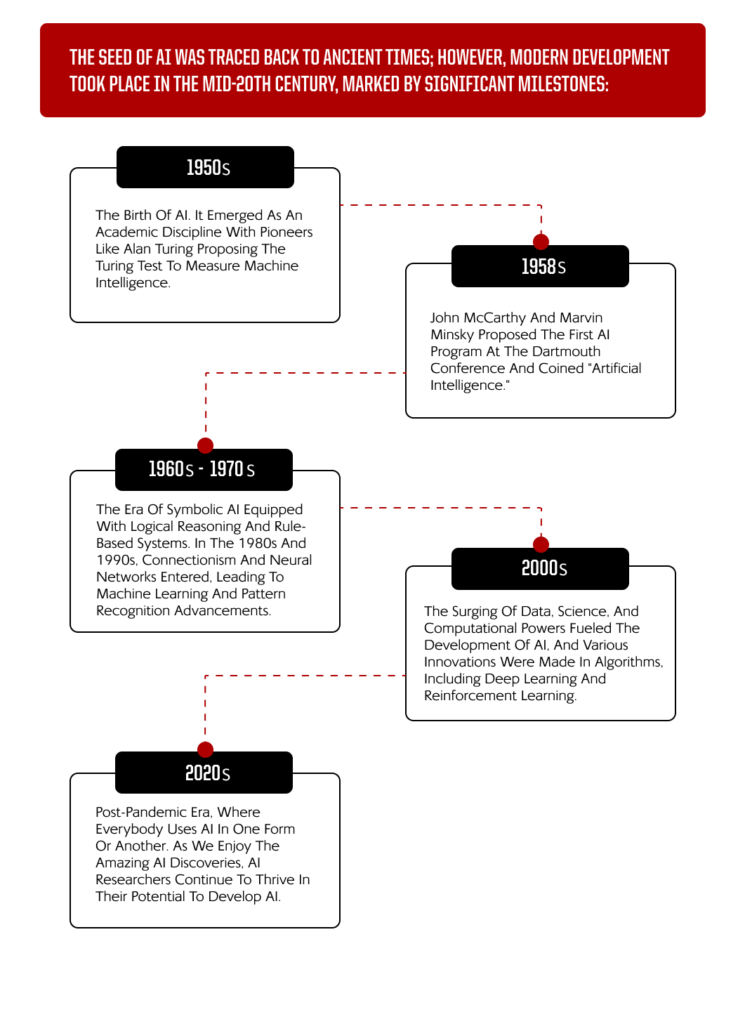
Branches of AI:
Artificial intelligence is a general term for a combination of fields that set the roots of AI, including its computational and decision-making power. Below are the seven important ones:
1) Machine Learning is when machines are trained using various mathematical algorithms and datasets to make decisions based on that data. In this, the accuracy of the output depends on the size of the dataset the machine is trained using.
The process starts with historical data collection, inputting instructions, and direct experiences to build a model for future reference. As the model gains experience, its accuracy improves with time, and it can make decisions without specifically being programmed. Many trending programming languages like Python and R are used for AI and ML.
There are three types of learning algorithms:
- Supervised Learning: This means using labeled data for machine learning and decision-making. Let’s take an example of building a model that recognizes the fruit images and gives their names. Such model types will be trained using a large dataset of fruit images with their names labeled on them.
- Unsupervised Learning: An unlabelled dataset is used to train the model. The purpose of unsupervised learning is to help the machine recognize patterns, relationships, and similarities between the data. For example- if we feed the model with a bunch of apple and banana images. The model has never seen any banana or apple in the past, but looking at the shapes and colors, it would classify the pictures into two groups- one of bananas and the other of apples.
- Reinforcement learning: Reinforcement learning is when a machine learns via try-and-get-errors methodology. It is learning through the feedback when a machine makes an action by interacting with the environment. The input can be positive or negative, using which machine takes the next move—for example- an ML-backed chess game model.
2) Natural Language Processing (NLP): The computer can learn, understand, and process human languages via voice or text. Virtual assistants, chatbots, and spam detection are the biggest examples of NLP. The models are trained using machine learning, linguistics, and deep learning models to understand the meanings, intent, and sentiment. As humans have different accents and intonations, recognizing speech can be challenging, which is why NLP techniques are used.
3) Computer Vision(CV): It is the branch that assists computers in recognizing and understanding images and visual information. Computer vision algorithms allow the computer to perform object detection, facial recognition, and image classification tasks. Its applications range from autonomous vehicles to medical imaging.
4) Neural Networks/ Deep Learning: Neural networks are also called artificial neural networks (ANN) and simulated neural networks (SNN). They mimic the human brain in how it passes information from one neuron to another. ANNs have node layers- Input (takes the input), Hidden (processes and transports the data), and Output Layer (gives the final result or prediction.) Each node, also called an artificial neuron, has other neurons with a threshold and weight. Whenever a node’s output touches the threshold value, it gets activated and sends the information to the next node. Neural networks need training for both learning and improving accuracy. Deep Learning is a neural network with 3 or more layers.” Visual recognition in self-driving cars so that they can recognize traffic signals, road signs, and people is an example of a neural network.
5) Robotics: It is a field of engineering that deals with robot conception, design, construction, and invention. Robots are programmatic machines that can take a series of actions. People can control them using a remote or their respective control systems. Robotics aims to create intelligent machines that can assist humans in various fields, including manufacturing, healthcare, and transportation. Humanoid robots are the latest developed and better-known examples of robots.
6) Expert Systems: These AI programs simulate the judgment and behavior of humans or an organization that is expert or experienced in a particular field. Expert systems are used in various fields like financial planning, customer service, and medical diagnosis. They are intended to complement human beings and not “replace” them. “CaDet” is a diagnostic expert system that helps medical professionals detect cancer.
7) Fuzzy Logic: Fuzzy logic lets computers make decisions in the form of “degrees of truth,” which lies between the digital values 0 and 1 (False and True). Have you ever solved a psychological assignment asking, “How often do you get angry?” and the options are very less(0), less(0.25), sometimes(0.5), often(0.75), and very much(1)? This is an example of fuzzy logic and how it considers all the possibilities between 0 and 1 instead of the basic true and false logic. Companies like Nissan use fuzzy logic to control break systems in dangerous situations.
Some Trending Examples of AI:
Think of your day today and count how many times you used AI. ChatGPT at work, Snapchat filters to click a selfie, Alexa to play music, and Google Maps to visit any location. You must use at least one or two of these almost daily. So, this is how common artificial intelligence is these days, and now, we are about to read some common and trending AI examples that we use in our everyday lives!
- ChatGPT: ChatGPT is one of the most used trending limited memory large language models (LLM) developed by OpenAI. As the name says, ChatGPT is a chatbot that can help humans through texts. If you want to write an email, research your next blog, need help with your school project, or surf for new Instagram reel ideas, ChatGPT can take care of it. Thus, be it work, education, or business, this chat AI helps individuals in day-to-day operations and makes their tasks much quicker and easier.
- Google Maps: Who hasn’t used Google Maps ever? No-one. No matter where you live or work, you must have used Google Maps at least twice or thrice. Google Maps is the first thing we open on our mobile whenever we want to plan a trip or visit a new location. It would be interesting to know that even this amazing innovation that helps us see any area on our mobile, all its street, indicates the traffic, tells duration, directions, and whatnot, uses AI algorithms to provide all these real-time insights. It analyzes large amounts of data, including traffic history and user inputs, to predict everything.
- Smart Assistants: Alexa, Siri, and Google assistants that almost help us daily to play music, call someone, answer questions, do voice chats, or do anything on our mobiles or other electronic devices are other examples of AI. These also use ML and NLP techniques to understand and interpret human commands.
- Self-Driving Cars: Self-driving cars rely heavily on AI to analyze, decide, and control their movements. It has embedded ML algorithms, deep learning techniques, cameras, and sensors to detect moving objects, interpret traffic signals, and navigate through complex roads.
- Wearables: In this era where people focus much more on fitness and health, smartwatches are another AI example widely used to track activities, SpO2 levels, heart rate, and sleeping patterns. Moreover, they provide personalized insights to improve overall health.
- Snapchat Filters and My AI: Snapchat is one such app that reached its peak by discovering the filters. Interestingly, these filters also use AI algorithms and computer vision for facial recognition and tracking movements to interact with the users.
Impact of AI on Society and Industries:
The integration of AI into society has brought a revolutionary change in the lifestyle of human beings. Whether in automation, healthcare, finance, transportation, or education, AI is playing its part effectively in almost all the running domains of the current world.
ML and AI-driven automation leads the industry with streamlined processes that save time and money and increase efficiency. From manufacturing and logistics to administration and teleperformance, automation is dramatically transforming operations and is yielding enhanced productivity.
With more accurate and fastened diagnosis, drug discovery, and personalized treatment planning, AI-backed systems are also proving to be a boon for the healthcare industry. ML algorithms are now embedded in various medical devices that help analyze medical images, genomic data, health records, and treatments, predict patient outcomes, and design targeted therapies.
Apart from this, AI is also making tasks like fraud detection, risk assessments, and trading trend predictions smooth for the finance sector. Facial recognition and biometrics make transactions much safer and more secure.
Hence, AI is proving to be a great discovery that complements the potential of humans, helping us save crucial resources like time and money.
Challenges and Future of AI:
The era of AI is still developing and running towards achieving more success. However, there are still a lot of challenges that need to be addressed before AI reaches heights.
- Decreased Employment Rate: The increasing use of AI in various industries has raised concerns about potential job losses and unemployment.
- Lack of Transparency: Most AI models are not transparent to users, so they never know their calculation mechanism, which could help them, particularly in tracking errors.
- Privacy Concerns: With AI utilizing huge amounts of data, there is always a risk of a data breach in case the algorithms fail.
- Security Risks: AI is making humans more vulnerable to cyber attacks, raising questions about the security of its users.
- Ethical Considerations: For instance, inventions like AI-backed autonomous weapons that can destroy life can be a dark side of AI, and hence, we must consider ethical aspects of AI development.
- Regulation: There must be a clear and effective regulation to ensure the responsible development and deployment of AI.
With this, we can conclude that the future of artificial intelligence is brimming with countless opportunities. As researchers are constantly working on going beyond the limits of Narrow AI, we can soon expect lots of inventions and innovations on General AI and studies on the implications of superintelligence. Thus, the technological future that we used to read about in books is close now!
Looking for the best AI development, integration, and consulting company? Look no further because BuildFuture AI has it all!

